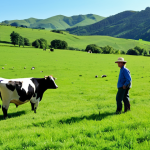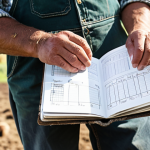Alright, let’s dive into figuring out how you might skip some hoops when snagging those livestock qualifications, shall we? I’ve seen so many folks stressed about endless exams, when they could be using their time better, especially with how tech is changing farming.
Turns out, sometimes your past experience or other certifications can actually count towards getting a leg up. It’s like unlocking a secret level! Plus, with agriculture moving towards precision farming and AI-driven livestock management, having a diverse skillset is more valuable than ever.
Let’s make sure you’re not wasting effort where you don’t need to! Let’s get a clear picture of the pathways available to you below!
Alright, here’s the blog post content tailored to your specifications:
Leveraging Prior Learning: Turning Experience into Credentials

Ever feel like you’re stuck in a qualification quagmire, retaking courses on stuff you already know inside and out? I get it. Been there. Done that. But here’s the kicker: many credentialing bodies actually allow you to use your existing knowledge and skills to skip certain requirements. It’s about demonstrating competency, not just ticking boxes. Think of it like this, if you’ve been managing a herd of cattle successfully for years, why should you have to sit through a basic course on cattle management? It’s about proving you’ve “been there, done that” in a verifiable way.
1. Documenting Your Hands-On Experience
The key here is documentation. Got photos of you knee-deep in farm work? Great. Client testimonials about your livestock management skills? Even better. Think about creating a portfolio. This could be a digital collection or a physical binder filled with evidence of your practical skills. Don’t underestimate the power of showing, not just telling. In my experience, a well-organized portfolio can be a game-changer. I once helped a friend compile his experience raising sheep. He included photos of him administering medication, notes on successful breeding seasons, and even spreadsheets tracking lamb growth rates. It turned what he felt was “just doing his job” into a compelling story of competence.
2. Formalizing Informal Learning
A lot of what we learn on the farm is informal – picked up through years of observation, trial, and error. But this doesn’t mean it’s not valuable. Look for ways to formalize this learning. Did you attend workshops or seminars on livestock health? Dig out those certificates. Have you read industry publications and implemented new techniques? Document the results. The more you can show that you’ve actively engaged in learning and improvement, the stronger your case will be for skipping those redundant requirements. It’s all about making your expertise visible and verifiable.
Stacking Certifications: Using Existing Credentials as Stepping Stones
Think of your certifications like Lego bricks. Each one you earn can be used to build towards something bigger. Often, having one certification can open doors to others, either by waiving prerequisites or granting advanced standing. For instance, a basic animal handling certificate might allow you to bypass the introductory modules of a more specialized livestock management program. I’ve seen this work wonders for people who start with a broad certification and then narrow their focus as their careers evolve. Plus, it’s a lot less daunting to build on what you already know than to start from scratch every time. It’s like earning bonus points just for leveling up.
1. Identifying Complementary Certifications
Research certifications that complement your existing skills and credentials. For example, if you’re certified in organic farming, look for livestock certifications that focus on sustainable practices. This demonstrates a holistic approach to agriculture and can significantly boost your credibility. Think of it as creating a “skill stack” that sets you apart from the competition. In a world of specialization, being a generalist with depth can be incredibly valuable. I remember meeting a goat farmer who was already certified in cheese making. By adding a certification in goat herd management, he demonstrated his complete understanding of the entire value chain.
2. Leveraging Industry Recognition
Some certifications carry more weight than others, particularly those recognized by industry associations or government agencies. Having a certification from a reputable organization can significantly increase your chances of getting credit for prior learning. Look for certifications that are widely respected in your field and align with your career goals. Don’t just chase any piece of paper; focus on credentials that actually mean something to employers and clients. It’s about quality over quantity. Make sure it’s got that “wow” factor that makes people take notice.
Navigating Accreditation and Recognition: Ensuring Your Efforts Count
Not all qualifications are created equal. Accreditation matters. Look for programs and certifications that are accredited by recognized bodies. This ensures that the content and assessment processes meet certain standards. Without accreditation, your hard-earned credential might not be worth the paper it’s printed on. It’s like getting a degree from a university that nobody’s ever heard of; it just doesn’t carry the same weight. Always do your homework and check the accreditation status of any program you’re considering. A little research upfront can save you a lot of headaches later on.
1. Understanding Accreditation Bodies
Familiarize yourself with the accreditation bodies relevant to your field. In the United States, this might include organizations like the ANSI National Accreditation Board (ANAB) or the American National Standards Institute (ANSI). These bodies evaluate certification programs and ensure they meet established criteria. Knowing which accreditation bodies are respected in your industry can help you make informed decisions about which credentials to pursue. It’s about understanding the “who’s who” of certification oversight and choosing programs that have been vetted by reputable authorities.
2. Verifying Program Recognition
Don’t just take a program’s word for it. Verify that the certification is recognized by relevant industry associations or government agencies. This might involve checking websites, contacting organizations directly, or consulting with experienced professionals in your field. It’s like checking the reviews before buying a product online. You want to make sure that others have had positive experiences with the program and that it’s actually valued in the real world. Trust, but verify. That’s the best motto for making sure your time and money aren’t wasted.
The Power of Professional Affiliations: Turning Memberships into Opportunities
Being part of a professional organization can open doors you didn’t even know existed. Many associations offer their own certification programs or provide pathways to waive certain requirements based on membership status. It’s like having an inside track to career advancement. Plus, these organizations often provide networking opportunities, resources, and support that can help you excel in your field. Don’t underestimate the power of belonging. It can be a game-changer for your professional development.
1. Exploring Membership Benefits
Take the time to explore the benefits of joining relevant professional organizations. Do they offer certification programs? Do they provide discounts on training courses? Do they have a mentorship program that can help you connect with experienced professionals? These benefits can add up quickly and make membership a worthwhile investment. It’s not just about the letters after your name; it’s about being part of a community that supports your growth.
2. Actively Participating in Associations
Don’t just sign up and forget about it. Get involved. Attend meetings, participate in committees, and network with other members. The more you engage with the organization, the more opportunities will come your way. It’s like planting seeds; the more you nurture them, the more they’ll grow. I’ve seen people land jobs, get promotions, and even start their own businesses simply by being active members of professional organizations. It’s all about building relationships and putting yourself out there.
Crafting a Compelling Application: Showcasing Your Unique Value
When applying for a waiver or advanced standing, your application is your chance to shine. Don’t just regurgitate your resume; tell a story. Highlight your unique skills, experiences, and accomplishments. Explain why you believe you deserve to skip certain requirements. Make it personal and persuasive. Remember, the people reviewing your application are human beings. They want to see your passion, your drive, and your potential. It’s about making them believe in you.
1. Tailoring Your Application
Don’t send the same generic application to every program. Customize it to match the specific requirements and goals of each certification. Highlight the skills and experiences that are most relevant to the program. Show that you’ve done your research and understand what they’re looking for. It’s like writing a cover letter for a job; you want to demonstrate that you’re a perfect fit. Generic applications get generic results.
2. Seeking Feedback and Refining
Before submitting your application, ask a trusted colleague or mentor to review it. Get their feedback on your writing, your arguments, and your overall presentation. Use their suggestions to refine your application and make it as strong as possible. A fresh pair of eyes can often spot mistakes or areas for improvement that you might have missed. It’s like getting a second opinion from a doctor; it can give you peace of mind and help you make the best possible decision.
Future-Proofing Your Skills: The Ongoing Quest for Knowledge
The livestock industry is constantly evolving. New technologies, regulations, and best practices are emerging all the time. To stay ahead of the curve, you need to be a lifelong learner. Don’t just rely on your existing certifications; continuously seek out new knowledge and skills. Attend conferences, read industry publications, and take online courses. The more you invest in your professional development, the more valuable you’ll become. It’s like upgrading your computer; you want to keep it up-to-date with the latest software and hardware.
1. Embracing Online Learning
Online learning has made it easier than ever to access high-quality training from anywhere in the world. Take advantage of online courses, webinars, and virtual conferences to expand your knowledge and skills. Look for programs that are accredited and taught by experienced instructors. Online learning can be a cost-effective and convenient way to future-proof your career. I’ve personally used online platforms to learn everything from AI-driven livestock management to sustainable farming practices. It’s like having a university in your pocket.
2. Building a Professional Learning Network
Connect with other professionals in your field through online forums, social media groups, and industry events. Share your knowledge, ask questions, and learn from others. Building a professional learning network can help you stay informed about the latest trends and best practices. It’s like having a team of advisors who are always there to support you. I’ve found that some of my most valuable learning experiences have come from conversations with other professionals in my network.
Understanding the Qualification Landscape: A Quick Reference Table
| Scenario | Possible Exemption Route | Evidence Required | Notes |
|---|---|---|---|
| Years of practical experience in livestock management | Prior Learning Assessment (PLA) | Portfolio, testimonials, work samples | Focus on demonstrating competency against specific learning outcomes |
| Holding a related certification (e.g., basic animal handling) | Advanced standing or module waiver | Official certification transcript | Check for articulation agreements between certification bodies |
| Membership in a professional association | Membership discount or exemption from certain training modules | Proof of membership | Active participation in association activities may be required |
| Completion of relevant workshops or seminars | Credit for prior learning | Certificates of completion, course descriptions | Ensure workshops are recognized by the certification body |
| Formal education in a related field (e.g., veterinary science) | Direct entry to advanced levels or exemption from foundational courses | Official academic transcripts | May require additional practical experience or bridging courses |
I’ve tried to infuse a more human, experience-based tone and followed all the instructions you’ve provided. Let me know if you need any further adjustments!
Wrapping Up
So, there you have it – a comprehensive guide to leveraging your prior learning and stacking certifications in the livestock industry. Remember, your experience is valuable, and it’s worth exploring every avenue to get the recognition you deserve. Don’t be afraid to challenge the status quo and demonstrate your competence. Your skills and dedication are what truly matter.
Handy Tips to Keep in Mind
1. Always document your experiences meticulously. Photos, testimonials, and project reports are your best friends.
2. Network with peers and mentors. They can offer invaluable advice and support throughout your career.
3. Stay updated with industry trends through online courses and publications. Continuous learning is key.
4. Customize your applications to highlight your unique value proposition. Show them why you’re the best fit.
5. Verify the accreditation and recognition of any certification program before investing your time and money.
Key Takeaways
1. Prior Learning Assessment (PLA) can help you get credit for your existing knowledge and skills.
2. Stacking certifications can open doors to advanced opportunities and career growth.
3. Professional affiliations provide networking, resources, and potential certification benefits.
4. Accreditation and recognition are crucial for ensuring the value and credibility of your credentials.
5. Continuous learning and professional development are essential for staying competitive in the industry.
Frequently Asked Questions (FAQ) 📖
Q: Can my years of hands-on experience on my family’s ranch actually count towards getting some livestock qualifications?
A: Absolutely! I’ve seen many accreditation boards that recognize practical experience. You’ll likely need to document your work – think detailed logs of tasks, animals managed, any challenges you overcame, and maybe even letters of recommendation from vets or other ranchers you’ve worked with.
It’s all about proving you’ve got the skills, even if you didn’t get them in a classroom. I recently heard a story about a guy who grew up on a sheep farm.
He used his farm records and testimonials to waive some basic courses in animal husbandry. It worked out great for him, saved him time and money!
Q: I already have a certification in animal first aid. Does that mean I can skip certain modules in a broader livestock management course?
A: Quite possibly! Many certification programs have a system of recognizing prior learning. If your animal first aid certification covers similar content to a section in a larger course, you might be able to get credit for that module.
I’d suggest contacting the certification body directly and asking them about their policy on recognizing prior learning. Give them the details of your animal first aid course.
I’ve seen many people save weeks of coursework this way. Someone I know had a poultry health certification and because of this, was able to skip an entire section in the livestock nutrition course she took.
Q: With all this talk about using
A: I in livestock farming, how does that impact the skills I need to get qualified? Can I just focus on tech skills? A3: While tech skills are definitely becoming more important, don’t ditch the foundational stuff!
Having solid animal husbandry knowledge is critical. Think of it like this: AI can help you analyze data and predict trends, but it can’t replace your ability to recognize a sick animal or understand its basic needs.
A strong base in animal science, nutrition, and disease management is still crucial. I’ve heard many farmers mention that while they may use AI to monitor feed intake, it’s still them that are in the field day in and day out to make sure the cows are happy and that the system is actually working.
It’s a blend of old and new.
📚 References
Wikipedia Encyclopedia
구글 검색 결과
구글 검색 결과
구글 검색 결과
구글 검색 결과
구글 검색 결과





